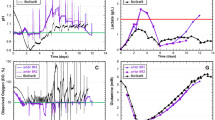Abstract
In order to guarantee the quality of recombinant therapeutic proteins produced in mammalian cell systems, the straightforward approach in industry is to run the processes as reproducible as possible. It is first shown that considerable distortions in the currently operated processes appear when the initial cell density deviates from its nominal value. Small deviations in the initial cell mass may lead to severe deviations from the desired biomass trajectory. Next, it is shown how to design a fed-batch production process in such a way that it is robust with respect to variations in the viable cell density. A simple open loop strategy is proposed for that purpose. Here we show for the first time at animal cell cultures (CHO cells) that by means of an appropriate glutamine feed rate profile F(t), which keeps the specific growth rate of the cells on a predefined value below its maximal value while maintaining the viabilities on a high level, the diverging viable cell count profiles change over into a robust converging set of profiles. The CHO cells used to validate the procedure could be focused to any specific growth rates below μmax.








Similar content being viewed by others
References
Ansorge S, Esteban G, Schmid G (2010) On-line monitoring of responses to nutrient feed additions by multi-frequency permittivity measurements in fed-batch cultivations of CHO cells. Cytotechnology 62:121–132
Butler M (2005) Animal cell cultures: recent achievements and perspectives in the production of biopharmaceuticals. Appl Microbiol Biotechnol 68(3):283–291
Charaniya S, Le H, Rangwala H, Mills K, Johnsonc K, Karypis G, Hu WS (2010) Mining manufacturing data for discovery of high productivity process characteristics. J Biotechnol 147:186–197
FDA (2004) Guidance for industry: PAT—a framework for innovative pharmaceutical manufacturing and quality assurance. http://www.fda.gov/cvm/guidance/published.html
Gnoth S, Jenzsch M, Simutis R, Lübbert A (2007) Process analytical technology (PAT): batch-to-batch-reproducibility of fermentation processes by robust process operational design and control. J Biotechnol 132:180–186
Gnoth S, Simutis R, Lübbert A (2010) Selective expression of the soluble product fraction in Escherichia coli cultures employed in recombinant protein production processes. Appl Microbiol Biotechnol 87:2047–2058
Jang JD, Barford JP (2000) Effect of feed rate on growth rate and antibody production in the fed-batch culture of murine hybridoma cells. Cytotechnology 32:229–242
Jenzsch M, Gnoth S, Beck M, Kleinschmidt M, Simutis R, Lübbert A (2006) Open loop control of the biomass concentration within the growth phase of recombinant protein production processes. J Biotechnol 127:84–94
Kuwae S, Ohda T, Tamashima H (2005) Development of a fed-batch culture process for enhanced production of recombinant human antithrombin by Chinese hamster ovary cells. J Biosci Bioeng 100:502–510
Ljunggren J, Häggström L (1992) Glutamine limited fed-batch culture reduces the overflow metabolism of amino acids in myeloma cells. Cytotechnology 8:45–56
Ljunggren J, Häggström L (1994) Catabolic control of hybridoma cells by glucose and glutamine limited fed batch cultures. Biotechnol Bioeng 44:808–818
Miller WM, Blanch HW, Wilke CR (1988) A kinetic analysis of hybridoma growth and metabolism in batch and continuous suspension culture: effect of nutrient concentration, dilution rate, and pH. Biotechnol Bioeng 32:947–965
Robinson DK, Memmert KW (1991) Kinetics of recombinant immunoglobulin production by mammalian cells in continuous culture. Biotechnol Bioeng 38:972–976
Tremblay Md, Perrier M, Chavarie C, Archambault J (1993) Fed-batch culture of hybridoma cells: comparison of optimal control approach and closed loop strategies. Bioproc Eng 9:13–21
Wong DCF, Wong KTK, Goh LT, Heng CK, Yap MGS (2004) Impact of dynamic online fed-batch strategies on metabolism, productivity and N-glycosylation quality in CHO cell cultures. Biotechnol Bioeng 89:164–177
Wurm F (2004) Production of recombinant protein therapeutics in cultivated mammalian cells. Nat Biotechnol 22(11):1393–1398
**e L, Wang DIC (2006) Fed-batch cultivation of animal cells using different medium design concepts and feeding strategies. Biotechnol Bioeng 95:270–284
Acknowledgments
The financial support from the “Excellence Initiative” of the German federal state “Sachsen-Anhalt” is gratefully acknowledged.
Author information
Authors and Affiliations
Corresponding author
Rights and permissions
About this article
Cite this article
Aehle, M., Kuprijanov, A., Schaepe, S. et al. Increasing batch-to-batch reproducibility of CHO cultures by robust open-loop control. Cytotechnology 63, 41–47 (2011). https://doi.org/10.1007/s10616-010-9320-y
Received:
Accepted:
Published:
Issue Date:
DOI: https://doi.org/10.1007/s10616-010-9320-y




